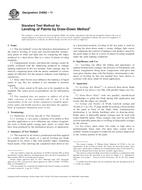We need your consent to use the individual data so that you can see information about your interests, among other things. Click "OK" to give your consent.
ASTM D7490-13
Standard Test Method for Measurement of the Surface Tension of Solid Coatings, Substrates and Pigments using Contact Angle Measurements
STANDARD published on 1.7.2013
The information about the standard:
Designation standards: ASTM D7490-13
Note: WITHDRAWN
Publication date standards: 1.7.2013
SKU: NS-38595
The number of pages: 5
Approximate weight : 15 g (0.03 lbs)
Country: American technical standard
Category: Technical standards ASTM
The category - similar standards:
Annotation of standard text ASTM D7490-13 :
Keywords:
adhesion, contact angles, dispersion and polar components of solid surface tension, solid surface tension, wetting, ICS Number Code 87.040 (Paints and varnishes)
Additional information
| Significance and Use | ||||||
|
5.1 The method described in this standard is based on the concept that the total free energy at a surface is the sum of contributions from different intermolecular forces, such as dispersion, polar and hydrogen bonding. There are other techniques that employ three components (dispersion, polar and hydrogen bonding). These methods are further complicated by needing three to five test liquids and are not practical for routine testing. This method uses contact angles of two liquids to provide data for the calculation of two components, dispersion, γ5.2 Dispersion and polar component data, along with the total solid surface tension, are useful for explaining or predicting wetting or adhesion, or both, of coatings on pretreatments, substrates and other coatings. Low solid surface tension values often are a sign of contamination and portend potential wetting problems. High polar components may signal polar contamination. There is evidence in the literature that matching of polar components of topcoats and primers gives better adhesion.5.3 Solid surface tensions of pigments, particularly the polar components, may be useful in understanding dispersion problems or to provide signals for the composition of dispersants and mill bases. However, comparison of pigments may be difficult if there are differences in the roughness or porosity, or both, of the disks prepared from them. 5.4 Although this technique is very useful in characterizing surfaces, evaluating surface active additives and explaining problems, it is not designed to be a quality control or specification test. |
||||||
| 1. Scope | ||||||
|
1.1 This test method describes a procedure for the measurement of contact angles of two liquids, one polar and the other nonpolar, of known surface tension on a substrate, pigment (in the form of a disk), or cured or air dried coating in order to calculate the surface properties (surface tension and its dispersion and polar components) of the solid. 1.2 The total solid surface tension range that can be determined using this method is approximately 20 to 60 dyn/cm. 1.3 The values stated in CGS units (dyn/cm) are to be regarded as standard. No other units of measurement are included in this standard. 1.4 This standard does not purport to address all of the safety concerns, if any, associated with its use. It is the responsibility of the user of this standard to establish appropriate safety and health practices and determine the applicability of regulatory limitations prior to use. |
||||||
| 2. Referenced Documents | ||||||
|
Similar standards:
Historical
15.4.2011
Historical
15.5.2010
Historical
1.7.2012
Historical
1.7.2013
Historical
1.2.2014
Historical
1.2.2010



 ASTM D4062-11
ASTM D4062-11 ASTM D4082-10
ASTM D4082-10 ASTM D4086-92a(2012)..
ASTM D4086-92a(2012).. ASTM D4138-07a(2013)..
ASTM D4138-07a(2013).. ASTM D4141/D4141M-14..
ASTM D4141/D4141M-14.. ASTM D4144-94(2010)..
ASTM D4144-94(2010).. Cookies
Cookies
